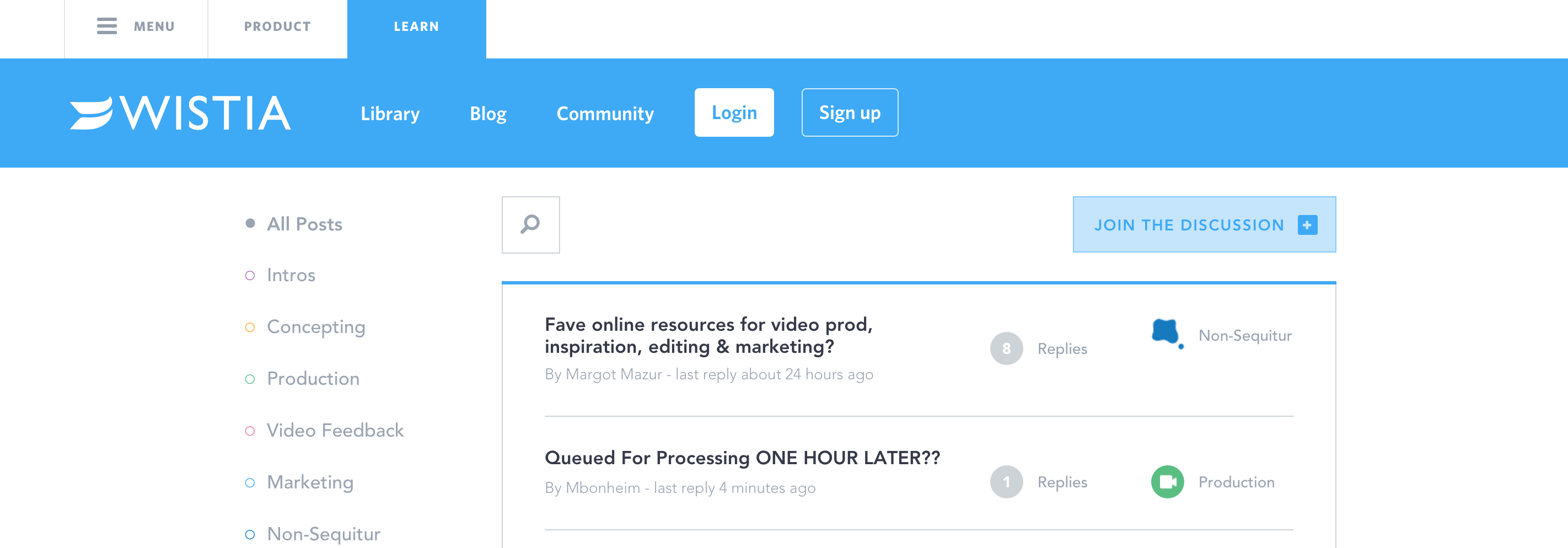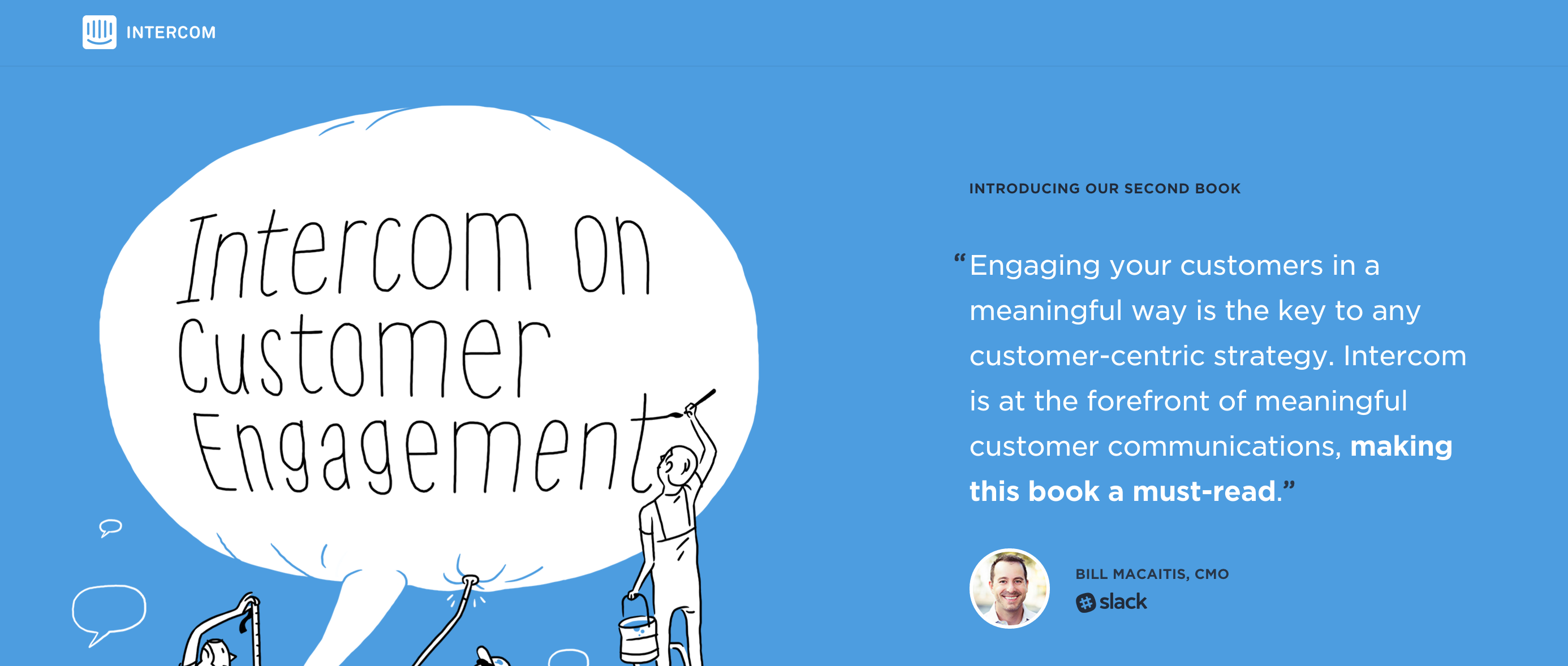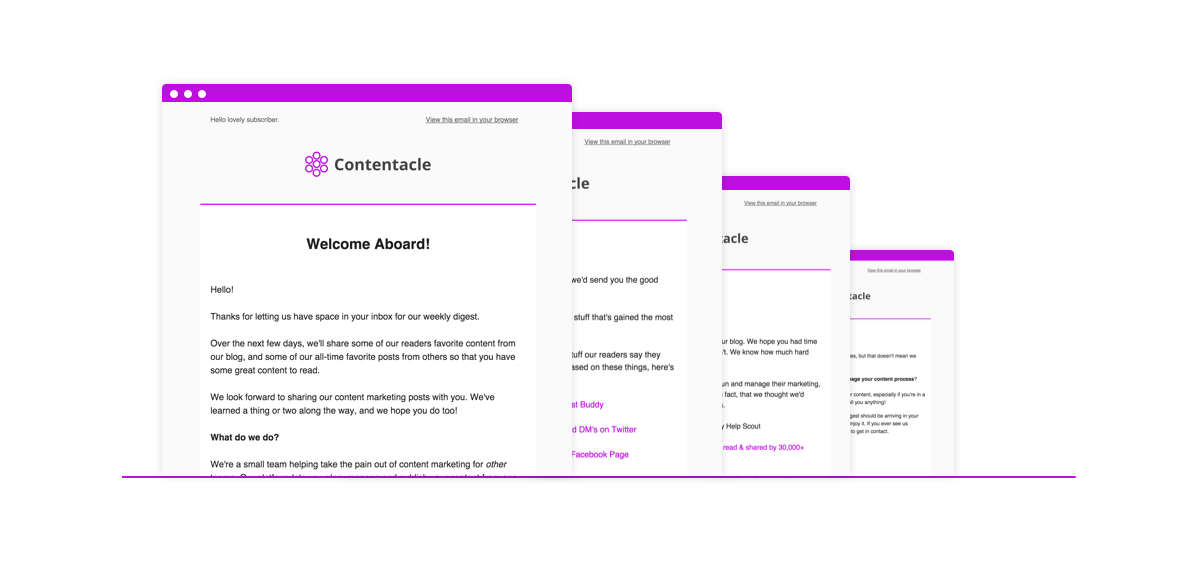
The Beginners Guide to Startup Content Marketing
December 12, 2015
Writing
If you’re struggling to gain results from your content marketing, or you just need a place to start from, read our comprehensive guide. We’ve got a ton of examples too!
What even is content marketing?

When a company creates valuable content for consumers, promotes it, and benefits from being the authority on a given subject, that’s Content Marketing.
The hope is that the person reading the content will begin to trust you and your startup because you provided them with value. It’s like sales without the sales.
According to The Content Marketing Institute, content marketing is:
A strategic marketing approach focused on creating and distributing valuable, relevant, and consistent content to attract and retain a clearly-defined audience — and, ultimately, to drive profitable customer action.
Content Marketing Institute
OK, so let’s break that down a bit:
1. Content marketing is about creating valuable content for the reader
 If you’re a startup and want to succeed with content marketing you’re going to need to create value for the reader.
If you’re a startup and want to succeed with content marketing you’re going to need to create value for the reader.
If you don’t, you’re not going to get very far. Startups that blog and create pointless, invaluable content for people may get some readership, but they won’t get a good readership. It’s 101 of startup content marketing.
Think about how you ended up here. I can’t imagine you just typed in our blog post URL because it magically popped up in your mind.
In fact, I’m guessing you’re here because you want to learn something that will benefit your business. So you thought of a keyword, typed it into Google, and clicked through to this blog. Or maybe you saw the title on social media and thought it sounded interesting. Either way it’s the value that brought you here.
Whether you’re creating blog posts, video or podcasts, you have to provide something valuable.
2. Be consistent in your approach to creating that value
 Having sporadic content will confuse your readers, and you won’t become friends with those search engine robots. You need to post to a schedule, and you need to have some idea of the type of content you’re looking to produce, plus how often you’re going to publish.
Having sporadic content will confuse your readers, and you won’t become friends with those search engine robots. You need to post to a schedule, and you need to have some idea of the type of content you’re looking to produce, plus how often you’re going to publish.
By having a consistent approach, readers will come to expect content from you, and that’s fantastic.
The more content they read from you, the more they’ll trust you. The more they trust you, the more likely they are to spread the word and then (hopefully) buy your product.
Below is the content marketing funnel that your readers will ideally go through.

At Contentacle, we post once a week (every week) and make sure to provide value for our readers. While we may post a day or two late sometimes, it’s a priority of ours to keep posting consistently. It’s important for us and our content marketing team to keep a good structure.
3. Have a clear idea of the person you’re writing the content for
 Creating content for a specific person is super important. Making a user persona (or three) is a fantastic idea, because it’ll help you characterize a person based on their education, location and job role, and write directly to them.
Creating content for a specific person is super important. Making a user persona (or three) is a fantastic idea, because it’ll help you characterize a person based on their education, location and job role, and write directly to them.
Your writing style will need refining and targeting too. You should write differently if you’re targeting lawyers to if you’re targeting yuppies.
Building a community
Having an online community is a fantastic way to spread your reach.
If done right, a community can spread your content and brand far beyond the reach a marketing campaign you spent thousands on could. In Seth Godin’s book—Purple Cow—he calls these community members ‘sneezers’.
Let’s take Wistia as an example. They’ve been in the video marketing game for nearly a decade now, but they’ve sure learned a thing or two about producing awesome videos in that time.
Instead of being secretive about the way they produce their video, they’ve chosen to be very open. An entire section of their website is dedicated to helping people learn about video. They even have a forum-like section to help answer questions that people may have.
Margot Mazur—the community manager at Wistia—gave me a little insight into why the company focuses so much on Community:
We dedicated a whole section of our website to community because community is an incredibly important part of providing Wistians with the resources they need to reach their goals.
Video marketing is tough and it seems as though the team know this. “We want Wistians to be incredibly successful with video marketing” she said.
“A great way to ensure that is to give them a place where they can seek feedback from other video marketers, talk about their experiences, help others, and make new friends. All of that goes into making Wistians wildly successful, knowledgeable, and on the cutting edge of video marketing”.
It seems as though the forum is less about trying to sell their service, and more about providing a place for video marketers to talk to one another. The benefit of course, is that they’ll generate more leads because of it—they’re providing value by hosting the forum for others.

By having this focus on community building, they’ve gone from being unknown in the shadow of YouTube to being a unique, community-driven company that takes pride in their culture and values.
This focus has in-turn helped them acquire customers like MailChimp and InVision.
Like other companies with popular blogs, they’re not trying to directly sell their product. They want to teach you something, create value, build trust, and then hopefully you’ll buy their product.
Create free, valuable content
Free content such as eBooks and guides help build trust.
eBooks are popular because they take a lot of time to develop, and people expect to have to pay for them.
Take Intercom for example. They’ve got three eBooks and a loyal reader base willing to exchange their emails for them. They may well spend time, resources and money creating these eBooks, but they reap the rewards of a larger and more engaged base of prospects.

They continue to grow rapidly, and have over 8,000 paying customers. Without the eBooks, they wouldn’t have enjoyed the same level of growth.
Contentacle itself is just a few months old but we’ve already started producing actionable content that our readers can use. We knew that people wanted to plan their content for 2016 so we created a guide just for that.
Struggling to come up with ideas to write about? Take a look at Quora for some ideas. Type in your general industry—we typed in ‘Content Marketing’—and take a look at the type of questions people ask. Then answer them on your blog with articles, eBooks and whitepapers.
You can add pop-ups and schedule emails to help with this startup content marketing.
Build your social following
Linking your site to your social media profiles will give you a boost and help you build a community. First identify where your target audience is, because it’ll take too much time to maintain a social profile on every network.
Once you know where they hang out, make social links obvious and easy to use. Let’s take a look at a few examples.
Buffer have links on their dashboard sidebar.

They make it super simple to connect with them on Twitter and Facebook. It’s just a click away, and every time you log into your dashboard it’s there, staring you in the face.

We have links on our email digest to follow our team on Twitter.
We like to focus on Twitter as our main social channel (we actually ditched our Facebook page early on) because that’s where we’ve found the most engagement.
Having a high engagement rate on social media helps with your community building. It means you can tweet about your content, and hopefully people will like, retweet and/or click.

Like Breather, many sites now show social links on their homepage footer. It’s become the norm, and many users now expect to see the links there. Give it a try and see if it makes a difference.
Build an email list
When you’re running a blog you have a great opportunity—building an email list.
When visitors stumble across your blog, they will hopefully get value from your content. If so, you’ll want to keep them coming back for more.

A great way of doing that is to capture their emails. By creating a list of emails, you can reach people that are interested in your content directly.
Here are some tools/resources to help you get started with an email list:
- [Bryan Harris & Jason Zook workshop](https://zp201.infusionsoft.com/app/linkClick/12847/bad4a2306011317e/3313567/4ff8745600dfd3e9). A fantastic workshop in which Bryan explains how to build an email list from scratch. No pitch included.
- MailChimp. A great email platform for anyone. Send campaigns quickly and easily with a drag & drop interface.
- Curated. Share your favorite articles from around the web effortlessly.
The great thing about an email list is that you have the chance to introduce yourself to the subscriber.
A welcome email or series is a must, because it means you can provide value from the get-go, introduce yourself and your team and provide them with your best content.

The Contentacle welcome series consists of 4 emails:
- A little about what we do and what to expect from the following 3 emails
- Curated list of our favorite and most popular articles
- Curated list of content from other companies (we like to share the content love)
- A question to find out about their current editorial process
I got inspiration from this HelpScout article, which shows how they welcome their subscribers. It’s well worth a read.
There’s one thing really worth noting when building your welcome series, though. The point of an email welcome series is not to sell. If you sell, you’ve lost your subscriber trust. You should explain what you do and why, but don’t try to push anyone to buy.
Content Marketing is a Team effort

You shouldn’t be left to ‘do’ content marketing by yourself. There’s two reasons for this:
You’ll get sick of it. If you’re the only one writing, editing, planning and publishing your company’s content marketing, you’ll start to hate it. As much as I enjoy writing content, I couldn’t do it on my own and you shouldn’t either.
You’ll miss some insightful content. Everyone on your team has a different perspective. If your readers are just seeing your perspective, they’ll get bored quickly. Bring in the CEO or Product Manager to write a piece every now and then.
Be sure to keep your team updated on your content performance at staff meetings, and ask around to get feedback and possible posts (or ideas) in the future.
If you want your coworkers to participate on your blog, don’t spring a post on them that’s due next week! Let them think about what to write and set up a casual chat to talk about it more first.
It’s not just coworkers who should be writing either—it’s guest authors too. There are many guest authors who are willing to write quality content for your blog because they get the benefit of expanding their reach.
Be open and honest about what you’re looking for from your guest authors, and don’t be afraid to give feedback. If have guidelines, provide them, and if not start writing down some key points you’d like to include.
It’ll help them improve and help you to form a friendly relationship with them in the future.
Final thoughts
If you’re going to run a blog, you have to go all in.
It’ll take time and effort to boost your search ranking, traffic and community.
If you’re dedicated, build an email list, optimize your conversion funnel and provide value you’ll reap the rewards of an engaged community.
Good luck!